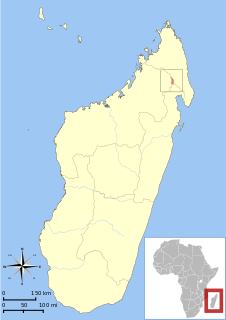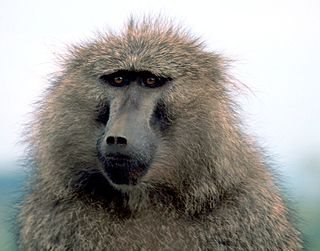
The Cheirogaleidae are the family of strepsirrhine primates containing the various dwarf and mouse lemurs. Like all other lemurs, cheirogaleids live exclusively on the island of Madagascar.

The titis, or titi monkeys, are the New World monkeys of the subfamily Callicebinae, which contains three extant genera, Cheracebus, Callicebus, and Plecturocebus. This subfamily also contains the extinct genera Xenothrix, Antillothrix, Paralouatta, Carlocebus, Lagonimico, and possibly also Tremacebus.

The giant mouse lemurs are a genus of strepsirrhine primates. Two species have been formally described; the northern giant mouse lemur and Coquerel's giant mouse lemur. Like all other lemurs, they are native to Madagascar, where they are found in the western dry deciduous forests and further to the north in the Sambirano valley and Sahamalaza Peninsula. First described in 1867 as a single species, they were grouped with mouse lemurs and dwarf lemurs. In 1870, British zoologist John Edward Gray assigned them to their own genus, Mirza. The classification was not widely accepted until the 1990s, which followed the revival of the genus by American paleoanthropologist Ian Tattersall in 1982. In 2005, the northern population was declared a new species, and in 2010, the World Wide Fund for Nature announced that a southwestern population might also be a new species.

Mittermeier's mouse lemur is a species of mouse lemur known only from Anjanaharibe-Sud Special Reserve in Madagascar. The species is named in honor of primatologist Russell Mittermeier, who is President of Conservation International.

The Amber Mountain fork-marked lemur, also known as the Montagne d'Ambre fork-crowned lemur or Tanta, is a small primate, and like the other lemurs, can only be found on the island of Madagascar. The species is named after the Amber Mountain National Park where they are found.

The dwarf lemurs are the lemurs of the genus Cheirogaleus. All of the species in this genus, like all other lemurs, are native to Madagascar.

Arnhold's mouse lemur or the Montagne d'Ambre mouse lemur is a species of mouse lemur endemic to Madagascar. Its holotype was first collected on 27 November 2005, and was first described in 2008. According to genetic tests, it is genetically distinct from its closest sister taxa, the Sambirano mouse lemur.

Margot Marsh's mouse lemur or the Antafondro mouse lemur is a species of mouse lemur endemic to Madagascar. Its holotype was first collected on 21 May 2006, proposed in 2006 by Andriantompohavana et al., and was formally described in 2008 by E. Lewis, Jr., et al. According to genetic tests, it is genetically distinct from its closest sister taxon, Claire's mouse lemur.

Lemurs were first classified in 1758 by Carl Linnaeus, and the taxonomy remains controversial today, with approximately 70 to 100 species and subspecies recognized, depending on how the term "species" is defined. Having undergone their own independent evolution on Madagascar, lemurs have diversified to fill many ecological niches normally filled by other types of mammals. They include the smallest primates in the world, and once included some of the largest. Since the arrival of humans approximately 2,000 years ago, lemurs have become restricted to 10% of the island, or approximately 60,000 square kilometers (23,000 sq mi), and many face extinction. Concerns over lemur conservation have affected lemur taxonomy, since distinct species receive increased conservation attention compared to subspecies.
The Montagne d'Ambre dwarf lemur or Andy Sabin's dwarf lemur is a species of dwarf lemur known only from Amber Mountain National Park and the surrounding area in northern Madagascar. It was identified in 2005, but not formally described until 2015. Its conservation status has not been determined, but it is at risk from deforestation and possibly hunting from nearby human populations.
The Ankarana dwarf lemur or Sheth's dwarf lemur is a species of dwarf lemur, part of the C. medius group, known only from northern Madagascar. It has been found in two reserves as well as two protected areas. It was identified in 2014, but not formally described until 2016. Its conservation status has not been determined, but it is at risk from habitat destruction due to daily resource extraction by local human populations.
Groves' dwarf lemur is a species of dwarf lemur known from Ranomafana and Andringitra national parks and surrounding areas in southeastern Madagascar. The identification was based on comparison of mitochondrial and nuclear gene sequences with other members of the C. crossleyi group. Individuals from this clade first came under genetic study in 1999 and were recognized as a new species in 2014, but it was not formally described until 2017. The lemur was named after mammalologist Colin Groves. Known from altitudes from 754 to 999 m, it is significantly larger than other members of the C. crossleyi group, with a 20 cm body length, a 29 cm tail, and a weight of 0.41 kg. While the conservation status of the new species has not yet been assessed, its presence in several national parks does not guarantee that it will not be threatened by deforestation ongoing on the island, or possibly by hunting.

Plecturocebus is a genus of monkeys known as titis.














